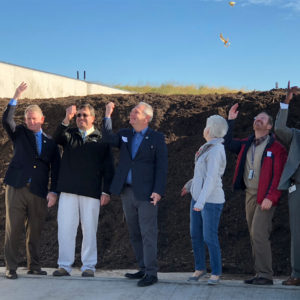As my sporty little Ford Focus puttered down Route 99 from the trailer park in HoCo’s Legislative District 9A that Robert and I have been parked in for the last week, on my way to “talk trash,” as he put it, with Jeffrey Dannis, the Chief of the Operations Division at Alpha Ridge Landfill (ARL), I thought of an article Robert had shown me once. It was about the archeological study of trash as a window into how past cultures lived. As interesting as Robert finds wastewater treatment, so I, Colleen, find solid waste removal.
“Studying ancient trash from around the world gives archaeologists and historians the chance to understand the habits that defined people’s daily lives,” said Dr. Richard Meadow, Director of the Peabody Museum’s Zooarchaeology Laboratory and Senior Lecturer on Anthropology at Harvard University, wrote Laura Allsop of CNN in 2011.
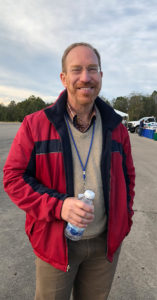
I wonder what they’ll say about how trash–or “solid waste,” in industry lingo–is disposed of in Central Maryland. Not that I know anything about archaeology, but I would think that when the survivors of climate change’s ravages look back at how we dealt with our garbage (which I enjoy pronouncing as if it were French–“gar-BAAZH”)–in Howard County, they’ll think the following: these people thought of everything in terms of the issues that arise when designing waste removal facilities and systems; Howard County cared deeply about the place it was and people that made it up; and, “All Together Now” was a super-cute slogan about how you can put all your recyclables in the same blue bin now (though you need to look at it the sticker on the bin to see what’s fits the label in “recyclables”).
Related: Robert also visited the Little Patuxent Wastewater Treatment Plant to report back.
The Wretched Refuse of Your Teeming Shore
So wrote American poet Emma Lazarus and is inscribed on the Statue of Liberty, inviting those who didn’t feel at home in their native land to the United States. I thought of Lazarus’ sonnet as I arrived at ARL, much as HoCo’s trash does every week to its home.
It’s always good to have someone bring me down to real-world concerns from my perch up in the clouds. There’s no one better to do that than Howard County Council member Hon. Jen Terrasa (D-3). I asked her about Alpha Ridge Landfill in a phone call from my cell phone balanced in its vent clip. As I waited to turn into ARL, she said: “Environmental concerns are a top priority for us here in Howard County, and Alpha Ridge has an important role to play in this.” I was about to find out just how important.
I turned from Marriottsville Road into the entrance to ARL expecting to see a vast expanse of trash, dingy and damp from the recent soaking rains we’ve seen here in HoCo the last few months, seagulls hovering above it, rats scurrying through it, and flies buzzing about. I never saw anything of the kind during the entire two hours that Jeff showed me around. At the entrance to ARL, I saw signs for where you can drop off almost anything you can think of for proper disposal, from hazardous materials to mattresses to TVs, and also several sign-based admonishments not to scavenge.
A young, handsome fellow named Tomontey Brown at the booth where cars enter greeted me with a big smile and directed me to where Jeff likely was. I wound my way down the path he put me on, and luckily, as even when you spell directions out for me I can get lost–just ask my nemesis, the GPS lady!–another genial man, this one named Mickey Estep actually stopped on the road, got out of his car, and pointed to where he had seen Jeff’s car headed to. As Robert found during his two hours at Little Patuxent Water Reclamation Plant, I was already impressed with how happy everyone seemed to be here, how much I could tell they enjoyed their work.
Speaking of handsome fellows, I parked next to Jeff, but for a moment I thought, “This guy can’t be him! This guy must be on-site to star in a commercial about solid waste disposal!” Both Robert and I are trying to tone done the fawning in our articles, particularly about people’s physicality. It rubs people the wrong way. But Jeff’s a cutie, let me tell you that much. He has a toned physique and Oriole-orange hair. When he told me how long he’s been in the industry, I did a double-take and couldn’t stop talking about how I thought he was at least 20 years younger than me. But he’s not! He’s been in the general area of waste “treatment,” if you will, of various sorts, since 1986. He got a Bachelor’s degree from Purdue University in Environmental Engineering and a Master’s in Engineering Management from the University of Maryland Baltimore County.
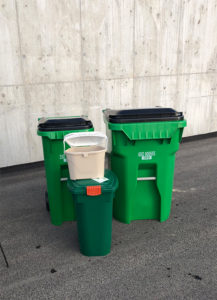
Jeff offered me some sunscreen, which he applied gingerly to his fair skin. I declined, but in retrospect, I probably shouldn’t have. I always think my olive-toned peau can take more solar punishment than it can. He also brought a water bottle along with him. I should have done that too. But now I know to bring all these things the…next time I visit a landfill..?
It was muggy and dusty, the kind of weather that makes you parched just talking about it. Jeff and I started talking about composting, as ARL is set to open a new composting facility on October 17th, a week away.
“We took the county and divided it into 15 different TRZs–Trash and Recycling Zones. Each one is about 5,000 homes, so it works out to about 75,000, and there are 80,000 homes in Howard County,” Jeff told me in the bouncy, up-and-down tonal cadence of a person happy and eager to fill you in on something, his voice rising at the end of each sentence.
Of those 15 TRZs, Jeff told me, 12.5 have curbside compost collection–grass, leaves, and twigs–that gets taken away. Three of those 12.5 have food scrap mixed in, and the compost of the remaining 9.5 homes zones goes to contractors off-site.
ARL sits on a sprawling 590 acres. A police and fire training center takes up 35 of the original parcel of land allotted for this vital space. Alpha Ridge Park takes up another 170 of it, which leaves the landfill with 385 acres. At the rate the county’s trash is filling up the site, ARL could be full to capacity in a few years. But there are important advantages to keeping ARL open. First, HoCo can choose to bury here if the alternatives get very expensive. Second, it’s important to have a place to put the the excess waste when storms hit. I noted this was a concern of increased importance given the frequency with which we experience tempests of all sorts these days in climate-changed 2018.
“Third, if we have space, we can use that freedom to bargain on prices for the trash we ship out of the county,” Jeff added.
“The landfill is permanent storage, because we throw away a lot of stuff that doesn’t break down or that breaks down slowly,” Jeff said of the most basic concern at ARL, as I asked increasingly trash-neophyte questions to make sure I understood exactly what’s involved in the rubbish-related goings-on there. Next we talked about recycling.
“Years and years ago, we built the first landfill cell in ’81 and we were filling it with trash. In ’91 the state changed the law and said you can’t just have a pile of trash with an earthen bottom. So we designed for a plastic liner and a clay liner to prevent contamination of the groundwater,” Jeff said.
To allay ongoing concern about various adverse effects area residents feared ARL might be having on them, the county hired a toxicologist to study the groundwater and the local stream, and she concluded that the groundwater was safe to drink. It didn’t exceed health standards. ARL’s neighbors remained skeptical, and the county made a decision to provide them with public water.
ComPost Office
The new composting facility at ARL is set to play an important role in creating the sustainable Howard County of the future.
“I started composting years ago while living in a different state, and I’m so excited at the prospect of being able to do it again here in Howard,” said Becca Niburg, an immigration attorney who lives in Elkridge.
China Williams, the Democratic candidate who’s running for a spot on the County Council in District 5 echoed Becca’s eagerness about the unveiling of the new composting capabilities HoCo-ers will have when I spoke with her.
You could think of the snazzy new composting facility that’s set to launch at ARL as an office where HoCo residents send their organic waste to be turned into a soil so rich, dark, and fecund, you almost want to eat it: a ComPost Office!
Jeff pointed out ahead of us how a series of rows of compost were having air drawn through them, hastening the process of organic waste turning to soil, by tubes inside it. And then he said something that stunned me: “So the microbes in there–those are my buddies.”
That’s exactly how Bill Holland, Engineer at the Little Patuxent Water Reclamation Plant spoke of the microorganisms that clean the water there when Robert visited him. Jeff and Bill both have such an intimate knowledge of and long relationship with their respective critters that they’re almost like family. Anyway, the compost cooks for 15 days at 131 degrees Fahrenheit to kill off pathogens. Then ARL sells it, mostly to contractors who need compost to mix into topsoil for various projects. Also, individual homes and master gardeners buy a good amount of it.
And then Jeff said something that stunned me even more: you can compost animal products! I had always been told you can’t. But in the relatively small amounts most households under normal circumstances would produce, animal products are A-OK to include in your compost, whether you have it picked up curbside or toss it into a pile in your backyard.
“You do want to be careful–here and in your backyard–to cover your compost, so you don’t attract scavengers,” Jeff told me when I got too excited about putting meat in the compost. “If you’re having vermin visit your pile, you’ll have to go back to just vegetables,” he added.
If your compost is providing a home to maggots, also, there’s a solution. Put more grass and leaves in it, layering brown material and green material to allow for air to get in the pile and keep away those creepy crawlies. Rotting isn’t what you’re going for, and that’s what happens when things are, in Jeff’s words, too “wet and gross.” Composting is aerobic, as he’d already mentioned. That’s why you want to allow air to get in your pile for aerobic decomposition to take place.
The website for the DIY network has a helpful tutorial on how to start a compost pile.
A breeze came by and blew my notebook paper over my cell phone, which was recording my talk with Jeff. I moved the paper off, and held it in place. We both squinted in the warm breeze as we continued to chat.
Since the ’90s, the county’s used contractors to manage its brush, grass, leaves, and manure. In 2009, it started investigating composting the material on its own, Jeff told me, and it considered including food scraps in the mix.
“After curbside collection of food scraps began in 2011, we knew we needed to bring back the work to the county,” Jeff said. He said that given the success Maryland’s had with composting, in those places where odor and leachate were problems, the state decided to process its compost in-house instead of scrapping the program all together. Moving the operations to Alpha Ridge was thought to be the most stable option to continue the program.
Visit the Department of Public Works site to see if you’re on one of ARL’s curbside compost pickup routes.
In 2009, Jeff designed a composting facility that would minimize odor and leachate. The pilot program he planned also allowed for heating of the compost so it would biodegrade faster than it would on its own. If waste turns to soil faster, ARL needs less footprint, or physical space, for the compost it takes in.
And: Robert went to the Maple Lawn Festival to explore its myriad, fun offerings.
“In addition to the curbside-collected material, we get 3,000 tons of grass and leaves every year and 16,000 tons of brush every year that we have to find the solution for,” Jeff said. It looks like we have that solution!
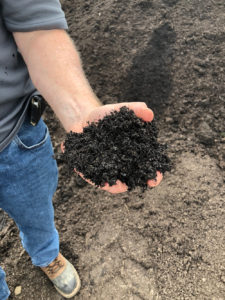
Ye Old Dumppe
“In the old days, you had to separate paper, plastic, and glass. Then we did the blue bags. Then we had the All Together Now,” Jeff reminisced about recycling in Howard County over the years.
Things improved but also got more complicated for the county after they instituted the All Together Now campaign to simplify recycling for area residents.
“The volumes of recycling went up significantly, but so did the volumes of trash. Especially, because there are wishful recyclers,” Jeff said, and I laughed, instantly knowing what he meant. “Wishful recyclers,” he said, smiling and gently nudging his glasses up the bridge of his nose are people who put something in their recycling bin hoping it gets recycled but not knowing so for sure.
“It doesn’t work that way,” Jeff said as we both laughed again and nodded “no” to each other. Once, Jeff opened a recycling bin to find a teddy bear in it. While they may be reusable, stuffed animals are not recyclable.
As the motors of cranes churned nearby and the beep-beep-beep of other vehicles backing up echoed through the air, Jeff walked me to a red barn on the site. He scaled the bumpy topography easily in his work boots. I hesitated in what struck me then as a rather prissy footwear choice for a couple hours at a landfill, the sneakers I wore to the gym.
The barn’s a historic building, and it looks relatively small on the flat land or ever-so-gently rolling hillocks that sprawl around it. We HoCo-ers love our historic landmarks, so the county decided to leave it standing even as ARL’s taken shape around it. I felt my nose twitch at a sudden gust of wind brought that familiar, sour smell of trash to us. Jeff seemed unmoved, especially since his trash manager paternal side kicked in with concern for a man in front us who wobbled on the roof of his pickup truck to fork a pile of grass and leaves into a heap over the side.
I asked what those gently rolling hillocks were, as I had a hunch they weren’t just part of the land. Call me a trash psychic. Jeff confirmed my hunch.
“It’s called entombing the trash. We don’t have open bits of trash,” he said as we both gazed at the bumps in the terrain ahead. They were like still, grass-covered waves. And like the ocean, they had a hypnotic power. Jeff told me they were closed landfill cells.
Mulch Ado About Nothing
Solid waste disposal isn’t just an industry, it’s also a business. As such, ARL produces a much sought after product: mulch. HoCo doesn’t manage the “problem” of its waste, but produces something people want and need from a good bit of what makes it up: wood! Jeff directed my attention to a grinder devouring a tree branch and spitting it out the other side.
“When you have a bag of mulch, you have the fines–the small pieces of wood and sawdust–and then the bigger pieces of stuff. We use the smaller stuff for compost and then we’re trying to make another product with the bigger pieces,” Jeff told me, pointing at piles of the kind of mulch you see in landscape architecture.
“Our challenge is to sell enough of our wood mulch to keep ourselves in regulatory happiness. The state requires us to move all of our wood product offsite every year, Jeff said. That challenge comes in because most people want dyed mulch for aesthetic purposes, he continued.
He grabbed a bunch of grayish mulch in one hand and dark brown mulch in the other hand to show me how it had faded from its original dark hue. It had dried up and gotten bleached in the sun. Because many people want mulch to retain its fecund color, however, ARL dyes its mulch with liquid, organic dyes.
Jeff told me that because ARL is a county venture, it can’t profit from the mulch, as that would give it an unfair edge in the mulch market.
“I need to price my material so that we don’t push other people out of the market,” he said.
A man drove his truck up to us and leaned out of his window.
“Hi, there. What can we get ya’?” Jeff asked him, like an avuncular landfill barkeep, putting one leg up on a small mound of earth in front of him. The man said he wanted two cubic yards of mulch, and and that someone would be by shortly to load it into the bed of his truck. Jeff told mulch-seeker that he could take credit card payment from him right there or he could pay using other forms of payment at the scales near the entrance. The mulch would be $21/cubic yard.
“We’re able to take about half the county’s yard trim,” Jeff said, opening his eyes wide then, while the rest is shipped offsite. The landfill’s biggest yard-waste-related challenge is taking in the increased compost volumes during “the fall leaf surge.”
Having a Gas
I asked Jeff if he ever worried about himself or his staff being exposed to the myriad chemicals that must lurk around ARL.
As with the trash itself, Jeff takes good care of himself and his staff, monitoring them through regular physicals and blood work.
“The microbes in the trash create methane and carbon dioxide,” Jeff said. Because of a law that prohibits ARL from allowing any gas to migrate off-site, the facility has a gas collection system that gathers and burns it. The facility also converts the gases the trash gives off into energy and sells them on the grid.
Cell Biology
The gentle hillocks I’d seen before, the closed landfill cells, are now about 30 feet lower than they started out, and that’s what Jeff and his team at ARL want. Landfill restrictions put limits on how high a cell can be, so solid waste disposal pros do what they can to help the moisture and anaerobic activity inside the cells break down the trash in them as fast as possible. In open landfill cells this is helpful, because if the trash settles, the air space can be used again. Even so, closed landfill is generally used-up space that isn’t going anywhere. At a landfill in New Jersey that Jeff worked at the staff discovered a purse inside it in good condition. Another time, they found a newspaper with the date easily legible on it from 1954!
Trash and Treasure
Jeff said he wanted HoCo residents to know that a lot of the trash that arrives at ARL leaves the site. When I asked if this meant it’s safe to live, work, and play near the site, Jeff demurred.
“The answer is I can’t tell you what’s safe. It’s like crossing the street. I can tell you there’s a car coming and it’s traveling at this speed from this far away,” Jeff told me nodding his head from side to side and smiling when I pressed him on the safety issue. “But you must make the judgment whether you can walk quickly enough to cross safely.”
Similarly, he continued, he can tell someone concerned about the county’s landfills about what programs the county has in place to protect the public and show them the results of site emissions test. Armed with that knowledge, county residents can and should make the final decision about what’s safe for them.
He also said that when he’s asked this question, he reminds people that there are other, more significant ways to ensure your safety and that of your loved ones. For example: what are you eating? Do you have radon detectors? Do you use low-VOC paint?
Predicaments and Predictions
I asked Jeff where he saw ARL and himself in five years.
“We may reach the point where they are in San Francisco, where Check and Reject inspectors open people’s recycling bins overnight,” he said. The inspectors put a sticker on the bins explaining that the city can’t take based on whatever particular contents inside prevent this. To delay HoCo’s arrival at this point, Jeff said residents should make sure to look at the labels on their recycling bins. Both products and markets are in a state of constant flux. Also, he said he and his staff welcome questions from the community. So come on down or call 410-313-6444.
Jeff said he intends to be in solid waste removal in some form in five years, too.
“A chemistry teacher in high school inspired me, and I said, ‘I’m going to be in solid waste removal.’ And I still am,” Jeff remarked, getting introspective at my encouragement. Still, Jeff’s husband wants to tour the world, and he works in a trade that has universal demand. He drew in a breath to continue on, and I held up my hand.
“Hold on, hold on, hold on. You love this work Jeff,” I said. “You have to stay in it, not just ‘in some form,'” I said, getting anxious at the thought of ARL and HoCo without him.
“I do love it. I do love it,” he said and blushed. We both laughed.
Before we parted ways, I asked him what he wants people to know about ARL more than anything. He had a quick, concise reply: “First: the catchphrase, ‘reduce, reuse, recycle’ is in that order for a reason. We should feel good about recycling, but responsible behavior starts with better stewardship. Second, look at the label on your recycling bin to see what the county accepts. And third, if you’re not sure about something, again, I and the rest of the folks at ARL are more than happy to help.” You can also go to Alpha Ridge Landfill’s official, comprehensive, and helpful website.
Everyone Loves a Banana Toss
That’s an old saying in comedy meaning, “It’s always funny to see someone slip and fall.” Luckily, no one fell on any of the bananas that Jeff and several county government luminaries tossed overhead to inaugurate the new composting facility a week after I initially met with Jeff and got the basics on trash, recycling, and compost in HoCo. The commemorative banana toss is what’s pictured at the top of this article.
The weather had turned suddenly brisk and autumn-like for the ribbon-cutting, and after an hour outside, my hands refused to move at their normal speed as I attempted to take notes. But the ribbon-cutting was a lovely affair including my favorite food (breakfast pastries), trash swag bags that contained actual soil from ARL’s compost, informative handouts, pencils, magnets, and more.
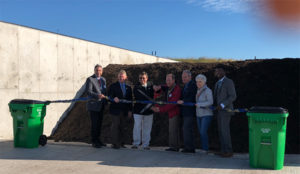
Just after remarks by several speakers, a handful of solid waste removal fans looked on and clapped as Jeff and those county government luminaries cut a ribbon in front of a large, lovely pile of topsoil.
I bid farewell to Jeff and my new ARL friends, and felt my gait halt a little. I wished we could all just hang out and “talk trash” longer. Perhaps in the future!
Thanks for reading! Check back with us here at rocoinhoco.com every week as Robert, Colleen (and pup, Moses) get to know the many facets—one each week–of this prismatic place called Howard County. We want to take you along with us, so follow us on Twitter at @rocoinhoco, join our Facebook group, and follow us on Instagram at @rocoinhoco.
